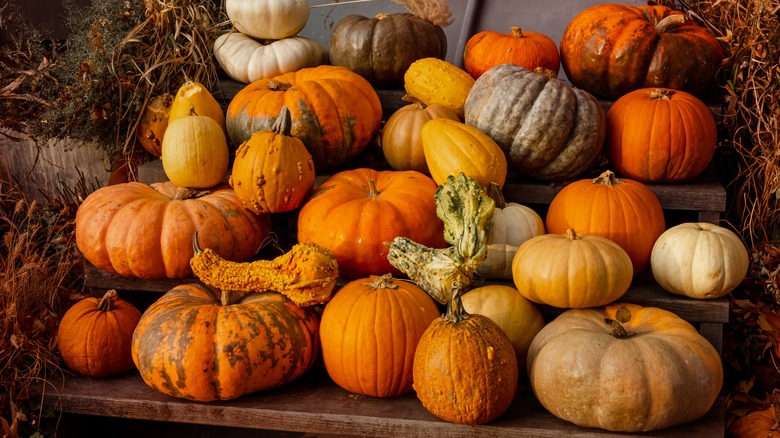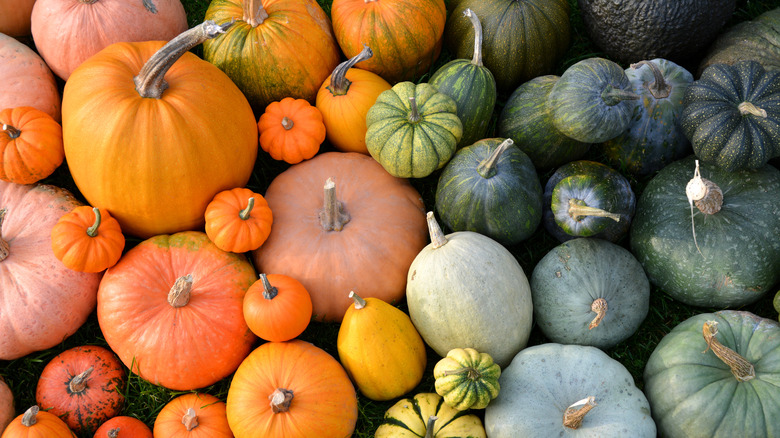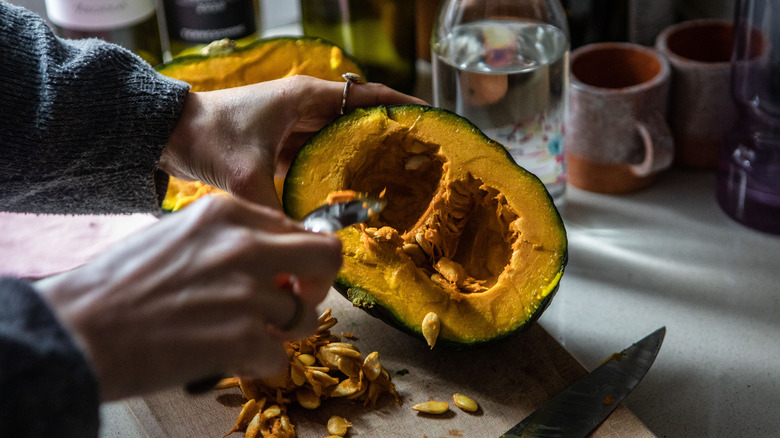How To Properly Choose A Pumpkin For Cooking Or Baking
If you've decided it's time to move away from canned pumpkin and into breaking down whole pumpkins, you can't just take any pumpkin from the grocery store or pumpkin patch. Or, at least, your dishes would turn out better if you chose one with intention. First, make sure you're buying a pumpkin bred for eating. Although decorative pumpkins aren't toxic, certain pumpkins are better suited for cooking with — like sugar or pie pumpkins. If it says carving or decorative, skip it. Next, make sure it's a good, solid specimen.
A pumpkin that has been harvested at the right time has developed great flavor and will last for at least two months. A pumpkin harvested too young won't be ripe, and one harvested too late after a frost may have already gone 'round the bend toward rotting inside. When you're choosing a pumpkin, whether it's out in the field or at the store, there are some things you want to look out for.
The first is a good stem, which forms a barrier against fungi and bacteria. Make sure it's well attached, not falling off at the junction of the pumpkin. If the pumpkin has a stem that has been cut quite short, that's okay — but make sure it has a stem. The next is to look for cuts and soft spots. If the pumpkin is cut, it's another pathway for fungi and bacteria. If the pumpkin is bruised and soft, it's too late.
Choosing the right type of pumpkin
Like all produce, pumpkins have been selectively bred for various qualities. Although you could eat a Jack-o-Lantern pumpkin, they're not ideal. They've been bred not for flavor and thickness of meat, but for thin walls and big, hollow sizes.
Usually, you'll readily find "sugar" or "pie" pumpkins. These squashes have been bred for high yields and thick layers of sweet flesh. They're not an unwieldy size and they're generally fairly smooth-skinned, compared to some of the rougher decorative varieties. If you're looking in a standard grocery store, these are probably what you'll find. If you're at a roadside farm stand or a pick-your-own patch known for its specialty heirloom varieties, though, it can be a much broader field!
Jarrahdale pumpkins can come in all sorts of skin colors, from gray to different shades of orange and subtle pinks. They have sweet, thick, orange flesh and are great for baking and cooking. A Cinnamon Girl is also a great all-arounder. Long Island Cheese pumpkins don't, in fact, taste cheesy, but look a bit like a wheel of cheese and have moderately sweet flesh for more delicate desserts. They — and the related French varieties Musquee de Provence and Rouge Vif D'Etampes — are wonderful for cooking. Marina di Chioggia is an Italian heirloom prized for its use in pastas and gnocchis. Winter Luxury pumpkins have a netted skin that could throw you off, but the flesh is incredibly smooth and (as the name suggests) luxurious.
Cooking and baking with a whole pumpkin
Some recipes will tell you that you can roast the pumpkin whole, without cutting it in half; it's less risky than attacking it with a knife, but it'll trap in more moisture, leading to a runnier purée. In Good Eats, Alton Brown suggests using a cleaver and a mallet to halve it. Gently place the cleaver on the pumpkin and tap the cleaver with the mallet to cut it safely. Scoop out the seeds and stringy innards (cleaned pumpkin seeds can be roasted).
Roast cut side down at 400 degrees Fahrenheit until easily pierced with a sharp knife, about 30 to 45 minutes if making purée. If you need cubed pumpkin, don't hurt yourself trying to peel and cube up the pumpkin. Roast it until al dente, and then prep it once cooled.
Let it cool at room temperature (Brown suggests an hour) to keep from burning yourself, and then scoop the flesh out of the skins and into a food processor. Blend until smooth — and you may notice it's a bit watery. This won't matter for soup but is important to note, especially if you're baking with pumpkin, as it may throw off recipes calling for canned pumpkin. In most cases, your home-roasted version will have way more moisture than the canned version. This can be addressed by draining the pumpkin before using it. Put the purée in a cheesecloth-lined strainer and let it drain. Now it's ready to use!


